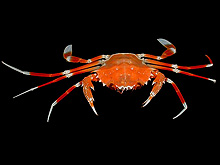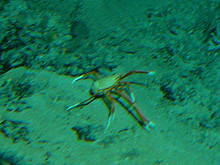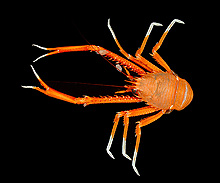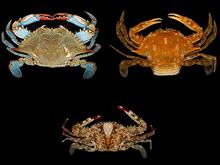
Left to right: The blue crab, (Callinectes sapidus), sargassum crab (Portunus sayi), and the blotched swimming crab (Portunus spinimanus) are all shallow-water “swimming” crabs in the family Portunidae. Note the paddle-like swimming legs. Click image for larger view.
Transitions to the Deep: Adaptations in Decapod Crustaceans for Life Along the 31º30N Atlantic Transect
Susan Thornton-DeVictor
Wildlife Biologist II
Southeastern Regional Taxonomic Center
South Carolina
Department of Natural Resources
Decapod crustaceans, commonly known as crabs, shrimp, and lobsters, are well represented in the South Atlantic Bight, from intertidal zones to abyssal depths. Members of this group are adapted to living in a wide range of environmental conditions along coastal areas, such as low salinity, emergent habitat, and high turbidity as well as complete darkness at depth. During the 2004 Estuary to the Abyss cruise, we will examine the decapod species that live along the "Latitude 31º 30’North Transect," from the shoreline to the edge of the continental shelf.
Estuarine/intertidal
Crabs and shrimp are familiar sights along the rivers and beaches, as
well as at the grocery store. The male blue crab (Callinectes
sapidus) spends most of his life in the estuaries in relatively
low-salinity water. After mating in low-salinity estuarine waters, female
blue crabs go into higher salinity water to release their fertilized
eggs. They must be able to acclimate to seasonal and daily changes
in salinity and water temperature to complete their life cycle.
Blue crabs belong to the family Portunidae, commonly known as swimming crabs. In addition to their walking legs and chelipeds (the large claw or pincer-bearing legs that extend forward), they have paddle-like fifth legs, which enable them to swim with ease. Another portunid species, the sargassum crab (Portunus sayi) also has swimming legs and spends most of its life on clumps of sargassum on the ocean surface. Walking legs and swimming legs are necessary in this type of habitat. Sargassum crabs also are highly cryptic; their mottled carapace (the thick shell that covers their back) blends in with the sargassum. Often, it is difficult to see them unless they move.
Grass shrimp (Palaemonetes vulgaris) are also found in estuarine, lower salinity water. They are translucent, which camouflages them and allows them to blend in with the surrounding environment.
Hard bottom/continental shelf
The deeper areas of the continental shelf (10-200 m) provide
habitat for a large number of decapods, particularly in areas with live
hard bottom. These areas contain sessile (attached at the base) fauna
and structures that provide protection, camouflage, and breeding grounds
for decapods adapted for living on the sea floor. Octocorals and sponges
are hosts to many decapods. The seawhip shrimp (Neopontonides beaufortensis) is
associated with the seawhip (Leptogorgia virgulata) and takes
on the octocoral's color, which varies from yellow to red. Snapping
shrimps (family Alpheidae) of the genus Synalpheus fritzmeulleri have
a large, powerful claw to intimidate predators, and they often burrow
in sponges for protection.
Swimming crabs of the Portunidae family also live in the offshore hard-bottom benthos. Lady crabs (Ovalipes sp.), Portunus spinimanus, and Portunus gibbesii are commonly found within the complex structure of the exposed reef.
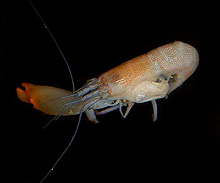
The snapping shrimp (Synalpheus fritzmuelleri) is commonly found in hard-bottom sponges. Note the parasitic isopod attached to the carapace. Click image for larger view.
Deep/continental slope
Because deep-water environments are very different from shallow coastal
areas, the organisms that inhabit them often have special adaptations.
Abyssal ecosystems exist below the euphotic zone, where there is not
enough sunlight to fuel photosynthesis. All organic material for
sustenance of the food web must be transported from the upper part of
the water column. Light cannot penetrate deeper than a couple-hundred
meters, so the deep-water environment is extremely dark and appears to be non-seasonal. Density-driven currents can be strong and, with the
exception of hydrothermal vent ecosystems, the deep ocean is relatively
cold. Despite these limitations, deep-water environments are home
to many organisms, including decapods.
Deep-water decapods are interesting and are rarely seen alive. Many are red in color, in response to the dissolution of the color spectrum in water. Red is the first color to be filtered out as sunlight passes down through the water column, so a red carapace appears black at depth. This provides camouflage and protection from predators. Deep-water decapods often have large eyes to detect bioluminescence and to compensate for the lack of light at depth.
Since food here is sparse, compared to availability at shallower depths, many decapods tend to be scavengers, dependent on rare foodfalls, such as dead fish and phytodetritus. Oceanic species, in general, tend to be less tolerant of temperature and salinity changes than their in-shore congeners (animals of the same family), which we can see when we bring deep water specimens from the cold depths up to warmer conditions. Little is known about the life cycle of most deep-water species of decapods, but it is likely that their early life stages as zoea and megalopae are spent in the zooplankton much higher in the water column.
One species of swimming crab (Bathynectes longispina) lives at depths as great as 600 m. This species resembles other members of the portunid family, except that it has long walking legs and reduced swimming dactyls (tips). Its large eyes and red exoskeleton provide a good illustration of deep-water adaptation. The armed shrimp (Heterocarpus ensifer), a deep-water caridean decapod, also exhibits the typical large eyes and red coloration.
Deep-water decapods have also adapted their size: they are relatively large. For instance, the deep-water squat lobster (Euminida picta) is a large galatheid decapod resembling a cross between a shrimp and a lobster. Shallow-water galatheids are generally small (10-20 cm) while E. picta may reach 30 cm in length. The golden deep-sea crab (Chaceon fenneri) is another example of large relative size, with adults having a carapace over 15 cm in width.
It is an enigma that in this deep-sea environment -- with such infrequent and sparse food availability -- that animals can reach these large relative sizes. It has been theorized that large body size allows greater mobility for scavenging and larger gut size to take advantage of sporadic food availability. (Indeed, necrophagous decapod species, such as Heterocarpus ensifer and Bathynectes longispina, visited our bait traps placed during the 2003 Ocean Explorer cruise to the Charleston Bump. Presumably, they sensed the “foodfall” from varying distances with their well-developed chemoreception capabilities.)
Abyssal decapods must also maintain physiological adaptations appropriate to the extremely high pressure and saturated dissolved oxygen levels to which shallow-water organisms are not exposed.
Marine associations/symbiosis from shallow to deep water
Both in shallow and deep water, many decapod species are involved in symbiosis (an interaction between two different organisms living in close physical association, usually to the advantage of both). For example, crabs in the family Pinnotheridae (pea
crabs) live an almost exclusively symbiotic lifestyle. In the intertidal zone, the oyster pea crab (Zaops
ostreum) lives its adult stage within the shell of the eastern
oyster (Crassostrea virginica), picking food from the oyster's gills. In its early life stages, the female pea crab is designed
for swimming and invading the oysters. While she lives within the
oyster, however, her carapace is thin and flexible, and her legs are no longer
adapted for free swimming.

The oyster pea crab (Zaops ostreum) is a parasite of the eastern oyster (Crassostrea virginica). Click image for larger view.
Also belonging to the Pinnotheridae family of pea crabs, Dissodactylus species are adapted to living on the spines of echinoids (i.e., sand dollars, sea biscuits). The echinoderms provide substrate and a food source for the crabs in an otherwise sandy environment. The crabs have specialized legs with dactyls that are forked to grasp the spines of the host. Juvenile spider crabs (Libinia dubia) associate with cannonball jellies (Stomolophus meleagris) in the open ocean. The crab’s legs have sharp dactyls that anchor the crab within the tentacles of the jellyfish. This association provides a dispersal method for the crab and accessibility to a food source which it would not normally have.
The deep-water glass sponge is host to an interesting transparent commensal shrimp in the family Spongicolidae. In contrast to symbioses, in which both partners benefit, commensals have a relationship in which only one partner benefits, but the other is not harmed. These shrimp enter the atrium of the sponge as juveniles and develop into adults that are too large to leave the sponge cavity. Although adults are confined to the sponge, their offspring can drift through the pores. Since the sponge is covered with a battery of razor sharp spicules, it provides a protective, permanent barrier for the shrimp, but allows free exchange of water and food.
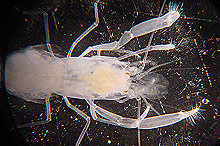
The glass sponge shrimp (Spongicoloides cf.) lives in the deep-water glass sponge. Click image for larger view.
From the intertidal zone to the edge of the continental shelf, decapods are abundant and have evolved adaptations necessary to live in a wide range of marine habitats. They have filled virtually every niche as scavengers, predators, herbivores, prey, parasites and commensals. During the Estuary to the Abyss Expedition, we will investigate the lesser-known species in the deeper water habitats along the 31º30’North latitude transect to add to our knowledge of crustacean ecology and taxonomy as a whole.


























